Reclaim Your Spine: Backbends to Counteract the Effects of Prolonged Sitting

In today’s digital age, prolonged sitting has become an unavoidable reality for many of us. While convenient, this sedentary lifestyle comes with a hidden cost: detrimental effects on our posture, flexibility, and overall well-being. Back pain, stiffness, and decreased range of motion are just some of the consequences of prolonged sitting.
Fortunately, a powerful antidote exists in the form of backbends. These poses, when practiced regularly, can effectively counteract the negative effects of sitting and restore balance to our bodies.
Understanding the Problem: The Impact of Prolonged Sitting
Sitting for extended periods puts our bodies in a state of static contraction. The muscles in our back and chest become shortened and tight, while the muscles in the front of our hips become stretched and weak. This imbalance leads to:
- Hunched posture: The shoulders round forward, the chest collapses, and the spine curves inwards, creating a “C” shape.
- Loss of flexibility: The muscles and ligaments around the spine become shortened and less flexible, limiting our range of motion.
- Compression on the spine: Sitting compresses the discs in our spine, which can lead to pain and discomfort.
- Reduced circulation: Blood flow to the legs and back can become restricted, leading to stiffness and fatigue.
Backbends to the Rescue: Restoring Balance and Health
Backbends offer a natural counterpoint to the harmful effects of prolonged sitting. By extending the spine and opening the chest, they provide a range of benefits, including:
- Improved posture: Backbends help to elongate the spine and pull the shoulders back, correcting hunched posture and promoting a more upright, aligned position.
- Increased flexibility: Backbends stretch the shortened muscles in the back and chest, improving overall flexibility and range of motion.
- Reduced pain and stiffness: Backbends can help to decompress the spine and release tension in the muscles, alleviating pain and stiffness caused by sitting.
- Enhanced circulation: Backbends improve blood flow to the spine and surrounding areas, promoting healing and reducing fatigue.
- Stress reduction: The act of practicing backbends can be meditative and calming, helping to reduce stress and anxiety.
Safe and Effective Practice: Backbend Poses for Optimal Results
Several backbends can be incorporated into your routine to counteract the effects of sitting. Here are a few examples with their specific benefits:
Bridge Pose (Setu Bandhasana): This beginner-friendly pose strengthens the back muscles, stretches the front of the body, and improves hip flexibility.
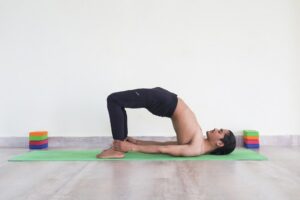
Cobra Pose (Bhujangasana): This pose opens the chest and shoulders, strengthens the back muscles, and improves spinal flexibility.

Locust Pose (Salabhasana): This pose strengthens the entire back, improves spinal flexibility, and tones the core muscles.
Bow Pose (Dhanurasana): This more advanced pose opens the chest and shoulders, stretches the spine, and strengthens the back muscles.
Wheel Pose (Urdhva Dhanurasana): This advanced pose is a complete backbend that stretches the entire front of the body and strengthens the back muscles.
It’s important to remember that everyone’s body is different, and some poses may be more comfortable than others. Always listen to your body and avoid pushing yourself beyond your limits. Starting with beginner-friendly poses and gradually progressing to more advanced ones is crucial for safe and effective practice.
Additional Tips for Optimal Results
Here are some additional tips to optimize your backbend practice and maximize its benefits:
- Warm up before you begin: Perform some gentle stretches or dynamic movements to prepare your body for the poses.
- Focus on your breath: Breathe deeply and evenly throughout each pose.
- Hold each pose for a comfortable amount of time: Start with a few seconds and gradually increase the hold time as you become more comfortable.
- Listen to your body: If you feel any pain, stop immediately and come out of the pose.
- Practice regularly: Aim to incorporate backbends into your routine at least a few times per week.
By incorporating backbends into your daily routine, you can effectively counteract the negative effects of prolonged sitting and restore balance and health to your body. Remember, consistency is key. With regular practice, you can experience the numerous benefits of backbends and enjoy a pain-free, flexible, and healthy spine.
Disclaimer: This article is for informational purposes only and should not be interpreted as medical advice. Always consult with your doctor before starting any new exercise program, especially if you have any pre-existing medical conditions.


